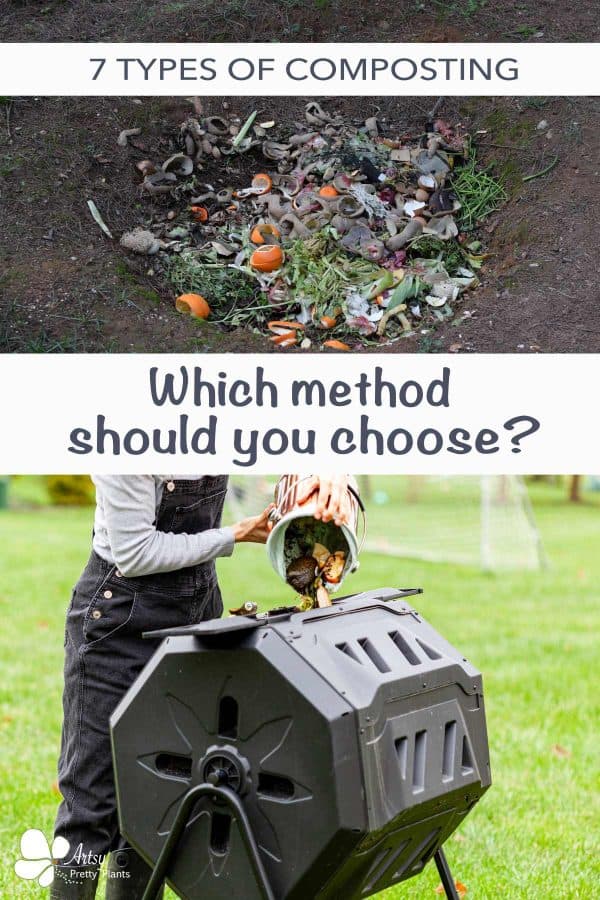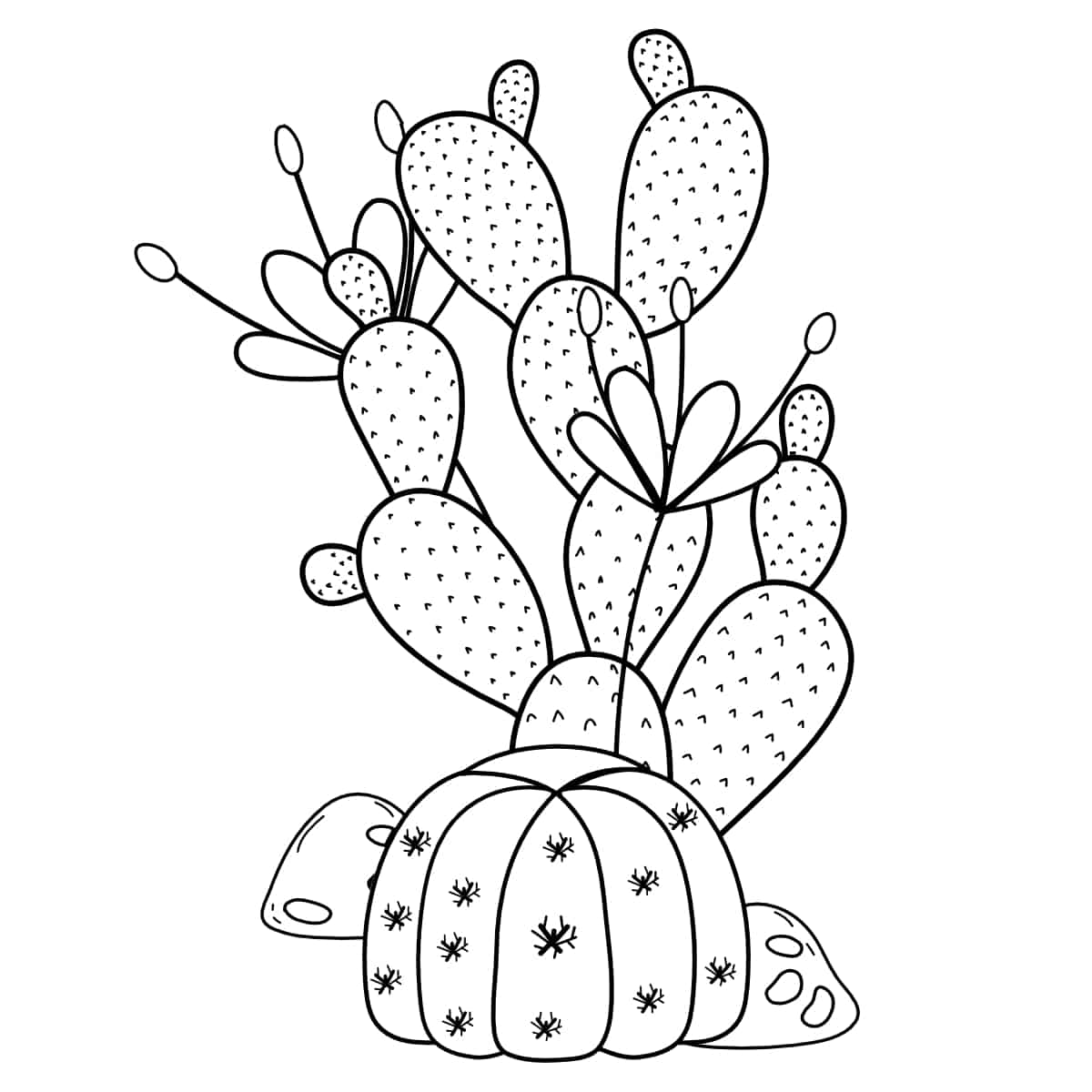Different Types of Compost (Which Is Best For You)
Composting can be an excellent tool for any gardener or plant enthusiast. But deciding how to begin can be challenging because different types of compost have different benefits and drawbacks.
Utilizing compost can be a great way to turn yard and garden waste into organic fertilizer and something useful, while also reducing waste.

Some of the links on this page have been provided as a convenience for finding materials. These links may also be affiliate links. As an Amazon Associate I earn from qualifying purchases, at no extra cost to you.
I only recommend products I’ve used and loved, unless otherwise stated. Click here to read my full disclosure policy.
According to the EPA, the average person produces 4.9 pounds of waste daily, only a small fraction of which is recycled.
While some things have no place to go but the landfill, you can compost many items, even some you wouldn’t have realized.
What Is Composting?
Composting is the process of recycling organic materials into a fertilizer that you can use to enrich garden soil and plants.
Generally speaking, organic matter consists of leaves, food scraps, grass clippings, and more.
All compostable materials decompose eventually. The composting process only speeds things up by providing the ideal environment for bacteria, fungi, and other organisms to work their magic.
Don’t forget to Pin it for later!

The result is known as compost, a substance that is rich in nutrients and can benefit gardening, horticulture, and agriculture. It is also sometimes affectionately referred to as “black gold.”
Different Methods of Composting
You can compost indoors and outdoors, and you can do it on small or large scales.
There are two main composting methods for backyard composting.
The best way to determine which of the different types of compost will work best for your home depends on several factors.
First, where you live, availability of space, how much organic waste your home produces, the kind of organic waste you produce, and the amount of time and energy you can spend on the process.
Cold Composting
Cold composting, also known as passive composting and anaerobic composting, breaks down organic matter slowly.
But it takes less effort and maintenance. There’s no need to worry about the ratio of compost ingredients, monitor moisture levels, or turn materials regularly.
This is a good choice if you don’t have much organic waste and little free time to devote to the process.
There are a few cons, though, regarding cold composting. It can take up to a couple of years to get usable compost.
Additionally, it will likely not reach temperatures high enough to kill off pathogens. It also may be smellier or wetter than a hot compost pile.
Hot Composting

Hot composting, also known as active composting or aerobic composting, is faster but takes much more hands-on attention.
This method requires attention to keep the optimal ratio of carbon and nitrogen.
It also requires the right balance of air and water to attract the organisms that thrive in this environment, so turning ingredients is necessary.
In ideal conditions, your finished compost can be ready in 4 weeks to 12 months.
Different Types Of Compost
There are several different types of composting. And some pros and cons come with each method.
Compost Bins
Using a bin is the simplest method for small, at-home composting. You can use a closed or open bin.
A closed bin keeps your materials together and helps retain heat and moisture.
Common containers include garbage cans, plastic container bins, wood pallets, and wooden crates.
Open-topped bins typically require less maintenance and work better for composting yard waste only.
ou can either buy a container or create one yourself. You can even just pile materials on the ground without an enclosure.
Trench Composting
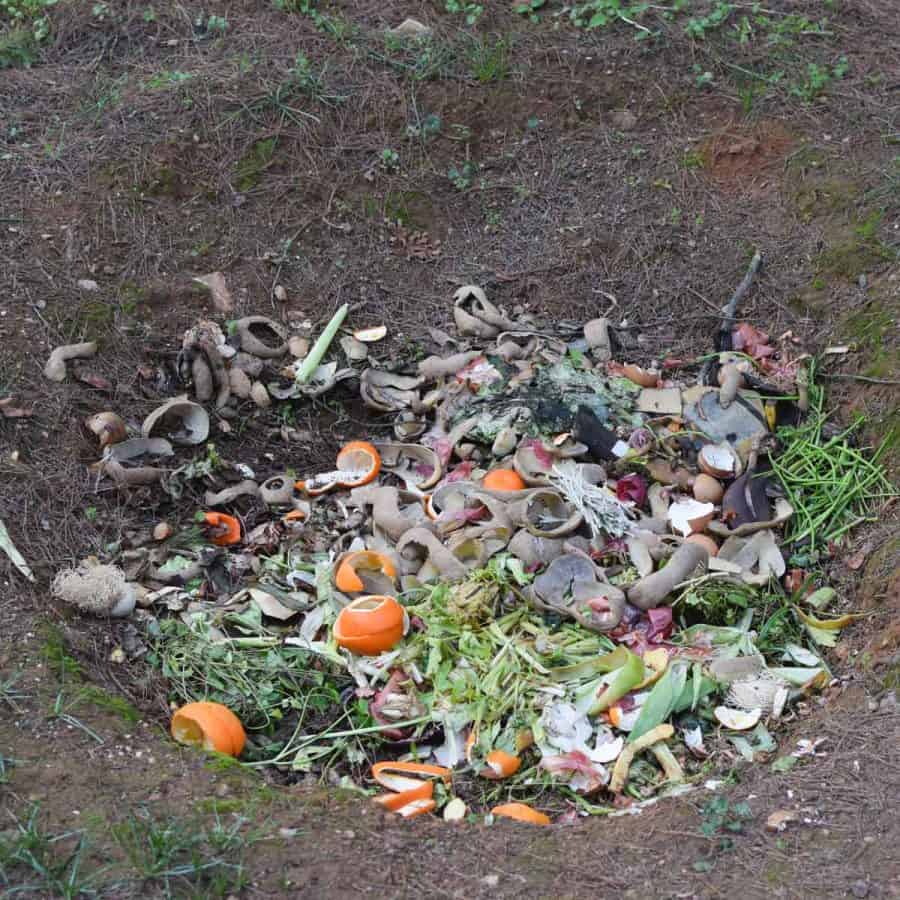
Trench composting consists of burying your organic waste directly into the soil. It can aid nearby plants in developing water-conserving root systems.
It is odorless and invisible. It can also be easier than maintaining a compost pile.
However, this method is best suited for a single instance of materials and is not practical if you want to compost on an ongoing basis.
Vermicomposting
Vermicomposting is a cold composting technique that uses worms such as red wigglers and red worms to digest organic matter and speed up decomposition.
Nightcrawlers and field worms (the kind you’ll find naturally in your garden and yard) are not appropriate for vermiculture.
It is a bit more complex as you need to nurture the worm’s growth and monitor the compost.
While it can be more difficult, this method may be ideal for apartments or small offices.
Temperature and moisture levels are important for this method. When the optimal conditions are met, the worms aerate the soil and promote aerobic decomposition.
Additionally, they enrich the soil with the enzymes and bacteria from the worm castings.
Vermicomposting must be done in a container, but make sure not to use copper or metal. You can create worm farms on a small or large scale.
Composting In-Place
Composting in place is the most basic form of composting. It is also sometimes called aerated static pile composting.
This cold composting method involves putting dead leaves, lawn trimmings, plant life, and similar items straight into your garden bed rather than moving the compost to another location.
In-Vessel Composting
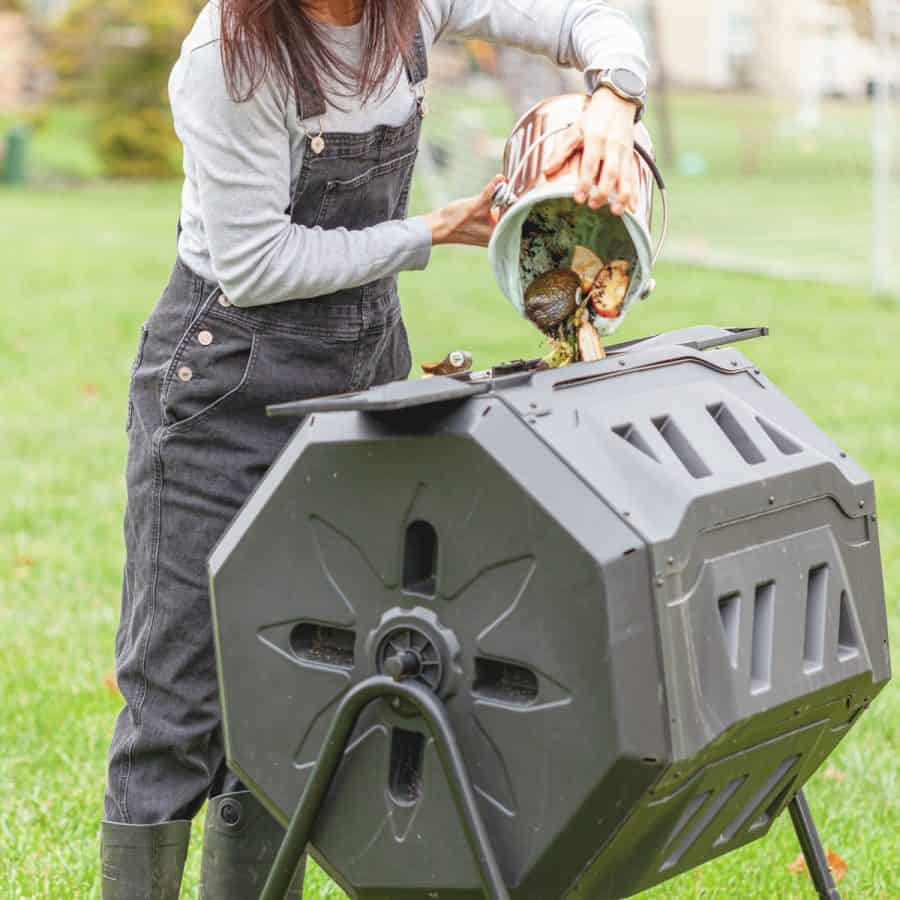
In-vessel composting, or tumbler composting, is an alternative to free-form cold composting piles.
A barrel or container is mounted to a frame, which allows you to spin it vertically.
Since the container is sealed, it helps generate high temperatures to speed up the process.
By turning it, you aerate and mix the contents, which helps foster aerobic conditions to break down the materials and speed up the process.
It is a good option if you have limited outdoor space. It also prevents pets from digging in the compost and helps control odors.
Bokashi Composting

If you’re in an urban area or have limited space, Bokashi composting, or EMO composting, is designed to manage a small amount of waste and uses a container that can easily be placed under your sink.
Aerated Windrow Composting
While this option isn’t suitable for at-home composting, it’s still worth mentioning if you have a farm or a small business.
But it is important to note that it is a large-scale operation subject to zoning and other enforcement.
The aerated windrow method produces large volumes of composted soil in a relatively small window of time.
The organic matter is composted into long piles called windrows.
Benefits Of Composting Yard Waste
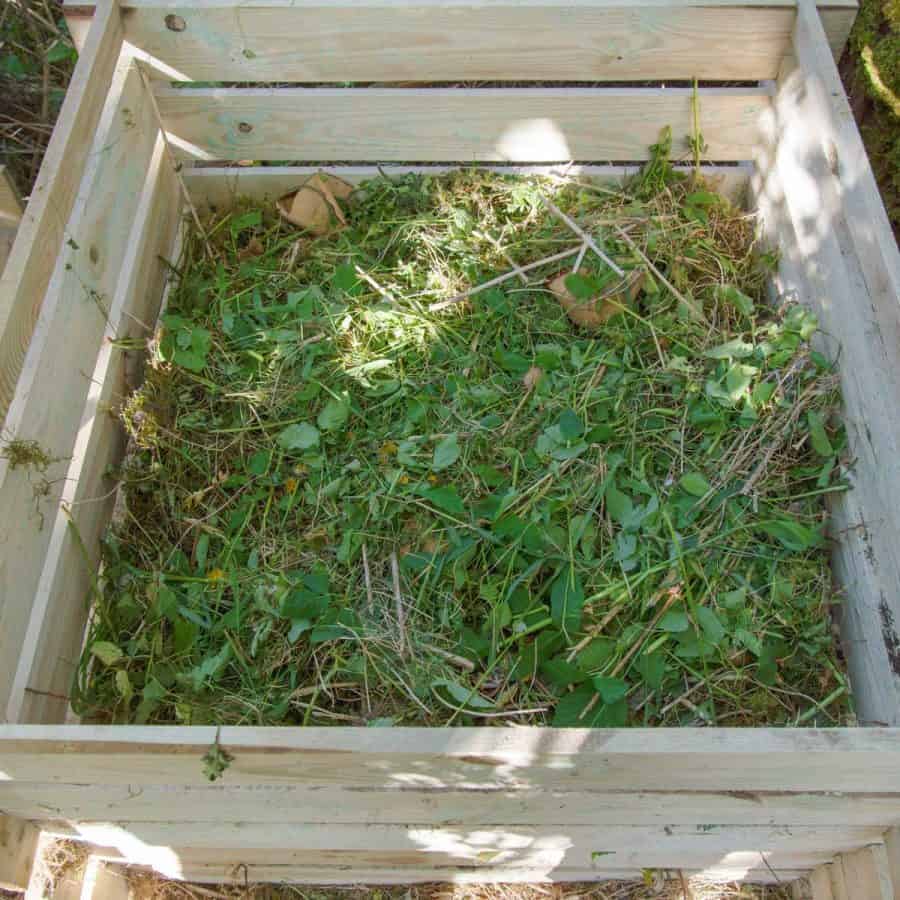
- Reduces waste
- Conserves water
- Improves soil health and lessons erosion
- Cuts methane emissions from landfills
- Helps to grow healthier plants
- Reduces personal food waste
Compost Ingredients
Four key elements are needed to decompose organic waste: nitrogen, carbon, oxygen, and water.
Composting is just a matter of using the right combination to achieve the best ratio.
Too much carbon will make the pile drier and take longer to break down. Less nitrogen and your pile will be wetter, slimier, and smellier.
- Nitrogen (Green Materials) – Green materials provide nitrogen and include fresh grass clippings, coffee grounds, and kitchen scraps.
- Carbon (Brown Materials) – Brown materials provide carbon and include items such as yard waste, dry leaves, dry weeds, yard trimmings, wood chips, cardboard and paper.
You can learn the ins and outs of composting with wood chips in this article.
The EPA does suggest leaving grass clippings on the lawn, also known as “grasscycling.” These decompose naturally and return some nutrients to the soil.
They also mention you can use leaves as mulch around trees and scrubs to retain moisture. Regardless, they can still be added to your compost pile if desired.
Do not add the following to your compost bin at home: dairy products, animal products, pet waste, yard trimming treated with chemical fertilizers or pesticides, coal or charcoal, black walnut tree leaves or twigs, and diseased plants.
Ways To Use Your Compost
Once your compost is ready and mature, you can use it in many ways.
- Use it as mulch
- Distribute it on lawns
- Mix it into your garden bed
- Add it to potting soil
- Feed it to potted plants
So as you can see, there are many different types of compost. But hopefully this gives you more insight into which methods will be more suitable for your specific needs.
For other great gardening posts, check out how you can transplant moss in your own yard to expand it. And this one for making a nearly weed-free gravel garden.
Don’t forget to Pin it for later!
